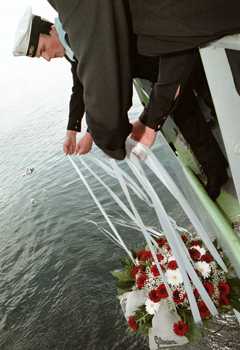Memory of sailors
returns
BY ALEXANDER
KRASNITSKY, CHAS DAILY. SPECIAL TO THE
SENTINEL
 |
| Latvian Navy sailors
lower the wreath presented by Chas into the sea.
Photo By Oksana Jedan/Courtesy Chas Daily, Riga,
Latvia | | RIGA, LATVIA -- "In the late autumn of 1939
and early spring of 1940 eight ships, one after one,
left this harbor. Sailors thought that it was to be an
ordinary run, some several months long. But it wasn't.
Their voyage still continues. Now the time has come for
this voyage to end where it began more than five dozen
years ago, in the home port of all eight steamers. To
end here, in Riga."
These words became a
watershed for many people in several countries spanning
half the globe: the words were pronounced at the opening
of ceremony held on Victory in Europe Day in the Latvian
capital city of Riga in honor of the crews of eight
Latvian-flagged vessels. After the Soviet Union
swallowed the small Baltic state in the fateful summer
of 1940, crews of these ships refused to recognize the
Soviet orders and never laid course to the nearest
Soviet port, as they were ordered. They went under
authority of the Latvian embassy in Washington and under
legal protection of the U.S., who never recognized the
incorporation of Estonia, Latvia and Lithuania into the
Soviet empire.
One and a half years later, when
WWII, after engulfing Europe, Asia and Africa, erupted
in the Western hemisphere as well, eight steamers --
with Latvian flags flying and under complete
jurisdiction of the Latvian legation in Washington,
joined the Allied merchant navy. Six out of the eight
vessels were sunk by Nazis in the course of first seven
months of 1942. The Ciltvaira was torpedoed Jan. 19 off
the Nags Head shores, and the Everelza was sunk by a
U-boat Aug. 13 several thousand nautical miles to the
south. Four more ships -- the Everasma, Abgara, Regent
and Everalda -- met similar fates in between. The crews
are the only known group of Latvian citizens who --
under their national flag and while in the jurisdiction
of legitimate Latvian authority -- fought the Nazis.
Even after losing six ships that equated to
three-quarters of its "firepower," they continued their
fight on board two remaining Latvian ships, named the
Kegums and Everagra, or under flags of other Allied
nations.
Emotionally their sea run continued
until May 8th, 2003 -- when Riga's Russian-language
daily Chas, with the support of the city authorities and
the National Defense Forces, unveiled a temporary
memorial plaque on the Riga building which -- back in
20s -- housed the maritime school where many of the
sailors trained.
"Today we are ending this
voyage," Regina Lochmele, the producer of Chas' sister
radio station, Nova, told the gathering.
It is
said that the day will come when the sea shall give up
her dead. It is not in a human's forces to do it, but a
human may resurrect the memory thought faded long ago.
When this writer contacted colleagues at the Outer Banks
Sentinel, none of us thought that two memorial events
would be held simultaneously on shores some 5,000 miles
apart. The facts of Latvian vessels' participation in
the Allied convoys were known before only to a small
group of history enthusiasts and not in every detail.
They came to be known to the wider society in Latvia and
elsewhere because of the Chas research series, produced
with the invaluable assistance of many sympathizers all
over the world, including the Sentinel.
Speaking
after Ms. Lochmele, Sergey Dolgopolov, vice mayor of
Riga, stressed the importance of society rediscovering
its history -- in full and without ideological
aberrations. In his words, the sailors of the eight
ships deserved not only a memorial plaque, but a
monument in Riga. The city council will consider
erecting it, Mr. Dolgopolov said.
 |
Alexey Sheynin, the publisher of
Chas, stressed that virtually every day the newspaper is
contacted by relatives of sailors who, on several
occasions learned about the wartime destiny of their
loved ones from the stories that Chas started to run in
mid-March. The work is far from over, he
said.
Indeed: for now, even the list of sailors'
names is far from complete. Chas was able to establish
slightly more than a half of them. However, judging by
the names, it is already clear that the crews of the
eight ships were multi-ethnic, reflecting the ethnic
diversity of Latvia. While ethnic Latvians were the
clear majority on board the eight steamers, Latvian
citizens of Russian descent, for example, served as
officers and average seamen on the ships. This fact,
which could be viewed as of secondary importance
elsewhere, resonates with the realities of today's
Latvia, still healing after five decades of strangling
Soviet rule, habitually labeled in the West as the
"Russian" occupation.
This writer was given the
honor of unveiling the plaque -- and did so under photo
blitzes and lenses of cameras of several TV companies.
Attendees -- including the Deputy Commander of the
Defense Forces Karlis Kreslinsh, Commander of the Navy
Capt. Ilmars Leshinskis and state secretary for the
Ministry of Foreign Affairs Maris Riekstinsh, as well as
several WWII Soviet Northern fleet vets, who themselves
served in the Allied convoys and as foreign diplomats --
applauded. Flowers were laid at the plaque.
The
second part of the ceremony was held on board the
Latvian Navy flagship Virsaitis, a 180-foot mine-layer.
The Virsaitis left the seaport of Riga, going along the
same routes as the eight ships once did. Under the
cloudy and unfriendly skies, she picked up speed and
headed down the Daugava River to the Gulf of
Riga.
There, some 10 miles offshore, it stopped.
Participants of the ceremony gathered at the stern. The
flag was lowered to half-mast, and the first wreath --
from Chas -- was lowered onto calm, but murky waters.
The moment it touched the surface, the dense cover of
dark clouds cracked unexpectedly, and bright sunlight
washed the deck of the Virsaitis. Two more wreaths and
flowers followed. Those on board who wore uniforms
saluted.
Navy Chaplain Rev. Viesturs Kalninsh in
his sermon stressed that the crews of the eight steamers
never betrayed either their Motherland or themselves.
"These sailors must not be forgotten," he said. He urged
everyone on board to observe a moment of silence in
"memory of those heroes who lost their lives and were
not honored before" because their country was controlled
by a brutal outside force.
"We returned a
long-overdue debt to those who risked their lives in the
name of freedom fighting in the most terrible of all
wars humankind ever knew. I do believe that the feelings
we all just have experienced will be with us for the
days to come. This ceremony must become a tradition, and
on May 8 of each forthcoming year we will lay wreaths in
memory of those brave sailors," said Capt. Leshinskis,
who addressed the participants in the ceremony after
Rev. Kalninsh.
Ksenia Zagorovskya, Chas' editor
in chief, accented yet another facet of the sailors'
saga: "We are starting to recognize that in the WWII
history of Latvia, not all pages were tragic. We have
reasons not only to mourn, but to celebrate and be proud
as well."
Father Theophan of the Russian Orthodox
Church closed the ceremony by saying, "For the Almighty,
everyone is alive. For living people, everyone is alive
while the memory lives. God bless the heroes who lost
their lives at sea!"
Then two ministers --
Latvian Lutheran and Russian Orthodox -- embraced each
other.
Under swiftly clearing skies the Virsaitis
set a course to the east, back to Riga, leaving behind
three wreaths and flowers, which slowly drifted
west.
|









